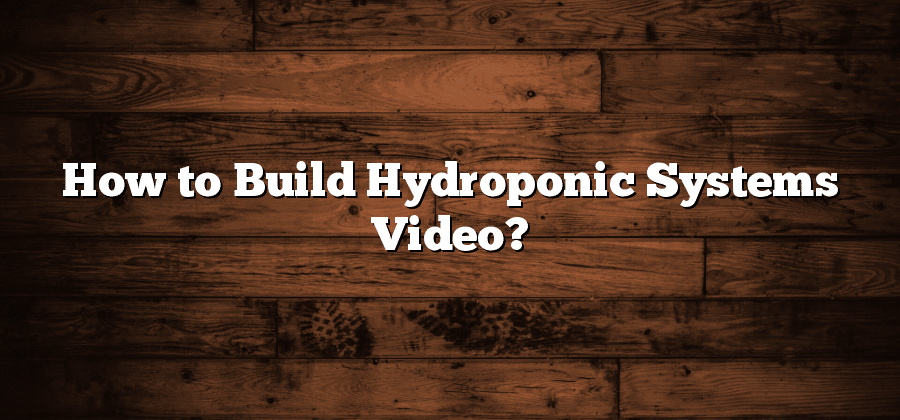Types of Hydroponic Systems
Hydroponic systems have gained tremendous popularity in recent years due to their efficiency and ability to maximize crop yields. These systems eliminate the need for soil and instead rely on water to deliver essential nutrients directly to the plants’ roots. There are several types of hydroponic systems available, each with its own unique characteristics and advantages.
One popular type of hydroponic system is the Nutrient Film Technique (NFT) system. In an NFT system, a thin film of nutrient-rich water flows over the roots of the plants, providing them with a constant supply of nutrients. This type of system is particularly well-suited for growing leafy greens and herbs, as it allows for optimal absorption of nutrients and oxygen by the roots.
Another commonly used hydroponic system is the Deep Water Culture (DWC) system. In a DWC system, the plants’ roots are suspended in a nutrient solution that is constantly aerated using an air pump. This type of system is ideal for growing larger plants such as tomatoes and cucumbers, as it provides ample oxygen to the roots and promotes rapid growth. The simplicity and low cost of setting up a DWC system make it a popular choice for both commercial growers and hobbyists.
Advantages of Hydroponic Systems
Hydroponic systems offer a range of advantages that make them an attractive option for both small-scale and commercial growers. One of the primary benefits of hydroponics is the ability to control and optimize nutrient levels. Unlike traditional soil-based methods, hydroponic systems allow growers to precisely tailor the nutrient solution to meet the specific needs of each plant. This not only promotes healthier and more vigorous growth but also ensures that plants receive an optimal balance of essential nutrients for maximum yields.
Another advantage of hydroponic systems is their efficient use of resources, particularly water. With traditional soil-based gardening, water is often wasted through evaporation and inefficient distribution. However, in hydroponics, water usage is significantly reduced as it is recirculated within the system, minimizing waste. Additionally, hydroponic systems are highly adaptable and versatile. They can be designed to fit various spaces and can be implemented in both indoor and outdoor settings, allowing growers to maximize production even in limited or unconventional areas. This flexibility makes hydroponics a viable option for urban farming and enables year-round cultivation regardless of the climate.
Essential Components for Hydroponic Systems
Hydroponic systems are gaining popularity among both hobbyists and commercial growers due to their numerous advantages. While there are various types of hydroponic systems available, they all require a set of essential components to function effectively. These components ensure that plants receive the necessary nutrition, water, oxygen, and support they need to thrive without soil.
One crucial component of a hydroponic system is the reservoir, which holds and circulates the nutrient solution. The reservoir should be made of food-grade materials to prevent contamination and ensure the health of the plants. Additionally, it should be equipped with a reliable pump and appropriate tubing to deliver the nutrient solution to the plants. The pump should be capable of providing adequate water and oxygen levels to ensure proper root development and nutrient uptake.
Another crucial component is the grow tray or pots where the plants are placed. These containers should be sturdy and durable enough to support the weight of the plants and the growing medium. They should also be designed to allow for proper drainage, preventing waterlogging and root rot. Additionally, the grow tray or pots should be light-proof to prevent algae growth in the nutrient solution.
Choosing the Right Growing Medium
When it comes to choosing the right growing medium for your hydroponic system, there are several factors to consider. First and foremost, you’ll want to assess the water retention capabilities of the medium. The growing medium should be able to hold enough moisture for the plants to absorb, but not so much that it becomes waterlogged or prone to root rot.
Another important consideration is the structure and stability of the medium. The chosen medium should provide support to the plants’ roots and allow for easy penetration and movement. A stable medium is crucial to prevent the plants from collapsing or falling over as they grow.
Additionally, the pH level of the medium should be compatible with the nutrient solution you intend to use. It’s essential to maintain the proper pH range for optimal nutrient uptake by the plants. Some growing mediums naturally have a neutral pH, while others may require adjustments using additives.
Lastly, consider the reusability and sustainability of the medium. Some mediums, such as coconut coir or perlite, can be easily reused, minimizing resources and waste. Choosing a sustainable medium aligns with the principles of hydroponics, which aims for efficient and environmentally-friendly growing practices.
By carefully considering these factors, you can confidently select a suitable growing medium that will promote healthy plant growth and maximize the yield of your hydroponic system.
Determining the Ideal Nutrient Solution
Determining the ideal nutrient solution for your hydroponic system is a crucial step in ensuring healthy plant growth and maximum yields. The nutrient solution serves as the primary source of essential elements that plants need to thrive in a soilless environment. It is important to have a balanced and well-formulated nutrient solution in order to provide your plants with all the necessary nutrients in the right proportions.
To determine the ideal nutrient solution, it is essential to consider the specific needs of your plants at different growth stages. Different types of plants and varieties have varying nutrient requirements, so it is important to research and understand the nutrients each plant needs at different stages of its growth cycle. Conducting regular water and soil tests can also give you valuable insights into the nutrient levels and deficiencies in your system. By monitoring the nutrient levels and adjusting the solution accordingly, you can ensure that your plants are receiving the right amount of essential nutrients to support their growth and development.






